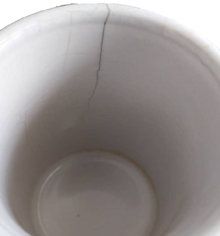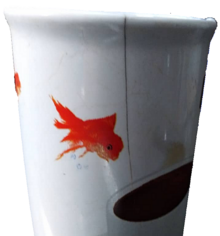Ceramicware Defects Handbook/Dunting
Jump to navigation
Jump to search
Dunting
[edit | edit source]Descriptions:
It is the type of cracks that passes through the pottery and formed as the result of thermal stress. There are many underlying causes but the trigger point is usually caused by thermal shock. Dunting is also more usually confined to glost ceramic wares as the ware has cooled down after being heated up.
There are types of dunting which are more dangerous that are "hot water dunting" (See pics attached). It occurs when hot water are poured into the ware ,where cracks formed on side wall, it may also occur at junctions where wall and base are formed together.
Solutions:
- Cracks are usually formed from corners and sharp angles. Therefore ceramic wares should be designed with the rounded shape. If there are angular holes or crevices, it is highly advisable to wet sponge the area to remove minute cracks which will be served as stress multiplier. Here are some design considerations to follow to minimizes dunting.
- Redesign the ceramic ware with rounded holes or rounded edges whenever it is possible. Avoid any of the sharp corners/angles
- Made the sections equally thick to prevent thinner sections dry faster compared to thicker sections
- Ensure the wall thickness (> 8mm and above) should be adequate to withstand compression and also the rapid expansion of glaze when exposed to boiling water
- The glaze should be as thin as possible as the glaze layer will exert compression force on clay as it cools down.
- Dunts spread readily in smooth dense clay body. Use lower firing temperatures and lower temperature glazes can help to reduce the dunting.
- Refiring may cause cristobalite in clay materials to form causing excessive shrinkage. It will fatigues the ceramic ware after each refiring. If the wares wouldnt be made good after 2 or 3 attempted re-firing, it is best to sell as second grade wares.
- Kiln are opened way much earlier during cooling down period. It is advisable to open up kiln only when the inside kiln reaches 150 C to reduce the thermal shock causing dunting
- If the ceramic wares are complex, it is advisable to "split up" to two piece from one piece to avoid accumulation of stress points.

